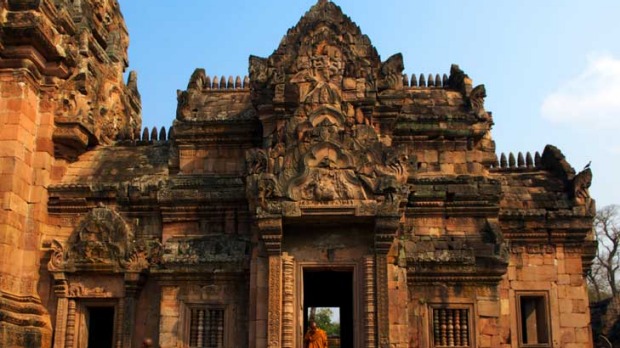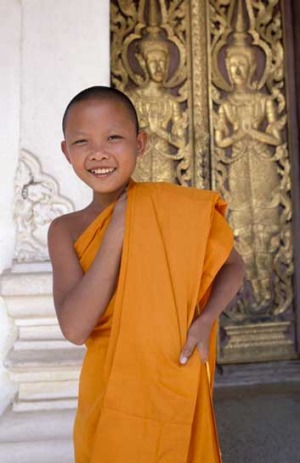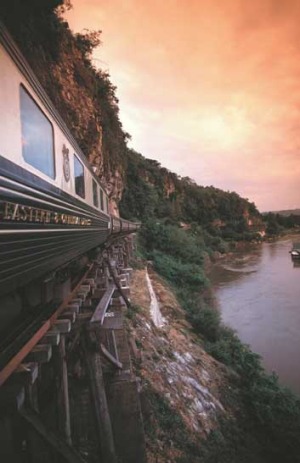
Ute Junker discovers adventure and indulgence go hand in hand on an epic journey by train from Bangkok to northern Thailand.
Rugged is not the word that comes to mind when you look at the Eastern & Oriental Express, berthed at Bangkok's Hualamphong Station. The green and cream carriages gleam, uniformed staff stand at attention at the doors of each carriage and a swath of Thai dancing girls is performing a graceful welcome dance.
Yet this is the train that will take us on a tour of some of Thailand's more remote destinations, showcasing the country's diverse cultures and landscapes and proving there's more to Thailand than Bangkok and beaches.

This is something of a departure for the Eastern & Oriental. The train's standard route, a three-night stretch between Bangkok and Singapore, is more about the journey than the destination. Like its sister train, the Venice-Simplon Orient-Express, the Eastern & Oriental is about travelling in time as well as space, to a time when the pace of life was slower, people dressed for dinner and breakfast was served by your steward in your cabin, rather than grabbed on the run.
This year, Orient-Express has introduced four separate six-night journeys designed to take guests into less-explored parts of Asia, while also allowing them to sink into a slower pace of life. Our Epic Thailand trip arcs its way through north-eastern Thailand before returning to Bangkok via the northern capital of Chiang Mai. I'm intrigued to see how the E&O manages the tricky feat of combining adventure and indulgence.
As the journey begins, the emphasis is definitely more towards the indulgence side of the scale. Compared with air travel, the departure process is wonderfully civilised. There's no baggage screening, no metal detectors, just a friendly welcome from your steward. The cabins are surprisingly spacious, with both a lounge (perfect for afternoon naps) and a comfy chair in front of a picture window. Trips are limited to 60 passengers, ensuring each guest has plenty of space.

It's also worth noting some of the things the train doesn't have. There's no TV or internet, gym or beauty salon. Any concerns we have about boredom setting in, however, are alleviated as soon as we discover the observation car.
This open carriage at the end of the train will become a favourite perch of mine during the next six days. All carriages, including the dining rooms and bars, have panoramic windows but there's an additional intimacy to sitting in the balmy tropical air while snatching swift peeks into everyday life as the train rolls on. It's better than channel surfing.
During the next six days, we pass through villages and vibrant green rice paddies, bustling towns and forest-clad hills. Sometimes we pass through railway crossings where rows of masked motorcyclists wait patiently for the train to go by. Other times, we pass pretty whitewashed railway stations kept shipshape. The unfolding panorama is fascinating.
Our first destination is in the north-eastern province of Isan. This is the Thai heartland, a distinctive culture with unique food, lifestyle and traditions. Our first stop is a visit to a traditional village, Ban Maichamuak, to get a sense for local life. We're warmly welcomed with a bai sii ceremony, designed to keep travellers safe on their journeys. It's performed by the village elders, who tie sacred threads around our wrists in the belief we will come to no harm.
After that, we gain some insight into the handicrafts that form the basis of the local economy, including basket making, silk production and weaving. Local fabrics have intricate designs, each belonging to a family.
What's phenomenal is that these patterns are not woven, as you might expect, from different coloured threads. Instead, each long thread is dyed a succession of colours, depending on its allocated place in the design. Threads are then painstakingly woven together. It's an incredibly complex way to work.
Bordering Laos, Isan was once part of the Khmer empire, which created the spectacular temples at Angkor Wat. The countryside here also has its share of gorgeous Khmer temples, most of which, because of their remote locations, receive few visitors.
Our visit to one of the most impressive, Panom Rung, takes place early one morning, before other visitors arrive. This 12th-century temple has a spectacular location on the rim of an extinct volcano, flanked by towering strands of centuries-old bamboo. The complex is guarded by fierce-looking carved nagas, or serpents, and every surface of the temple is intricately carved.
Most carvings depict episodes from Hindu legends, although occasionally a cheeky sculptor seems to have slipped one past the foreman. A pair of carvings by one doorway depicts two monks studying the sacred books they hold in their laps. One monk looks solemn, the other has a smile on his face. Look closely and you'll see the smiling one is holding the book with one hand: the other hand seems to disappear into his loose loincloth. No wonder he's looking happy.
We spend a day in Chiang Mai - where excursions on offer include everything from shopping and sightseeing to visiting an elephant camp or meeting with monks to discuss the practice of Buddhism - before heading south. Not far from Chiang Mai lies the city of Lampang, where we have one of our most memorable excursions.
Lampang is the only city in Thailand to have kept the horse-drawn carriage as a form of public transport. As we disembark the train early in the morning, a row of carriages is waiting to take us on a tour of the town. Unlike most Thai cities, which continually reinvent themselves, Lampang has maintained much of its traditional architecture.
We clip-clop through wide avenues lined with grand Thai mansions and buildings that hint at the town's multicultural history - the magnificent Wat Sri Chum, a Burmese-style Buddhist temple with its pagodas tiered like a wedding cake, is directly opposite the Alfalah Mosque. The winding streets of the riverside quarter have a more intimate feel, with narrow Chinese shop-houses jostling for space.
Our carriage ride culminates at an elegant teak mansion called Baan Sao Nak ("the house of many pillars"). Supported by 116 solid wooden pillars and filled with traditional furniture and antiques, lacquerware and handcrafted silver, it offers a glimpse into a world that has disappeared. Morning tea is served under the canopy of a 130-year-old sarapee tree that protects the front of the house.
So far, although we've clambered around temples and trekked through villages, it's all been easy going: the biggest challenge we've faced is the slightly muddy streets in Ban Maichamuak. Our most intrepid adventure is still to come: a trip to Khao Yai National Park. This landscape of plunging valleys and densely forested mountains has long been a refuge for endangered animals such as Asian elephants and tigers.
With more than 70 mammal species making their home in the park, from deer to monkeys, more than 340 species of birds and thousands of plant species, we feel certain that we'll see something interesting.
However, Orient-Express is not about to let its guests traipse into the rainforest unprepared. Before we set off, we're issued cream-coloured leech socks. They're worn over our own socks but inside our shoes and are closed tightly under the knee.
As gibbons hoot unseen in the canopies, each group later returns with stories of encounters. Some have seen giant squirrels leaping through the trees; others follow elephant trails and see trees rubbed bare where the pachyderms have used them as a scratching post. As we make our way out of the park, we run into a number of cheeky macaques loitering by the roadside, watching the passing traffic.
The forest excursion has helped us work up an appetite. Passengers on the E&O are among the best-fed people in Thailand and I've learnt to skip breakfast to leave room for the three-course lunches, served in elegant dining rooms. The sophisticated menus - think an entree of hot butterfish tart, followed by a masala chicken roulade on lemongrass risotto, with pineapple crumble and lime sorbet for dessert - are an impressive achievement, particularly once you've seen the small galley in which the kitchen staff work.
Should that not be enough to get you through the afternoon, your steward will always be willing to serve afternoon tea in your suite. You might, however, want to save your appetite for dinner, which will again be a multi-course extravaganza, with an amuse-bouche just to kick off things. Menus range from barramundi fillets served with Asian pesto, rack of lamb with a pistachio and pine nut crust served with a red wine sauce, to a creamy fish curry and desserts including a warm chocolate pudding.
As we conclude our forest walk, however, we're to have lunch off the train, at a vineyard nearby. Khao Yai National Park is flanked by some of Thailand's up-and-coming vineyards, including the acclaimed Gran Monte, where lunch is served. Just as we're settling in, heavy clouds scoot in over the valley and the rains begin. Most diners move inside.
Feeling comfortable and dry under our umbrella, we ask our waiters if they're happy to serve us out here. Being E&O staff, they oblige and we sit, confident the shower will pass.
To our surprise, the rain gets harder. Fortunately, we all have another item in the E&O survival kit: plastic rain ponchos. Giggling, we pop them on, pull the hoods up over our heads and cheer as the waiters valiantly brave the downpour to bring us our main course.
The rain continues to grow heavier. Although our top halves are covered, our bottom halves are getting drenched. Our main courses are now floating on the plates. Finally, we admit defeat and - to the relief of our waiters - go inside.
The experience, we decide, definitely qualifies as an adventure.
The writer was a guest of Eastern & Oriental Express and Thai Airways.
Getting there
Thai Airways flies daily, non-stop from Australia to Bangkok, from $1256 (low season). 1300 651 960, thaiairways.com.au.
Touring there
The next Epic Thailand journey departs on October 30. Prices start at $9600, which includes meals and alcoholic beverages. The Eastern & Oriental's other six-night itineraries include Fables of the Hills, which takes in Malaysia's Cameron Highlands, the bridge over the River Kwai, Kuala Lumpur and Georgetown. Its Legends of the Peninsula journey takes guests from Bangkok to Kuala Lumpur via the beaches of Trang. The three-night Tales of Laos travels to Vientiane via markets and golden temples. 1800 000 395, orient-express.com.
tourismthailand.org.